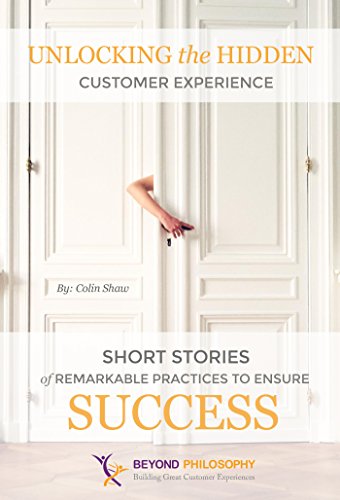Unlocking the Hidden Customer Experience Book by Colin Shaw, Review
About The Book:
Unlocking the Hidden Customer Experience Book by Colin Shaw, Colin Shaw’s new eBook, “Unlocking the Hidden Customer Experience: Short Stories of Remarkable Practices that Ensure Success” explores both the philosophy behind great Customer Experience and the best (and worst) real-world examples of them. As the founder and CEO of Beyond Philosophy and author of four best-selling books on Customer Experience, Shaw uses his expertise to point out where today’s companies are using their Customer Experience to foster an environment conducive to Customer loyalty and retention—and where they aren’t.
Many companies understand that having an excellent CX is the next great competitive differentiator for organizations. Fewer of them, however, understand the importance of creating a deliberate emotional and psychological experience that sends the right signals to meet Customer’s expectations. Companies must decide whether they want to delve into the emotions of their current experience and finesse them to evoke a deliberate response or be content with whatever happens by accident.

Book by Colin Shaw
Even if you are in the business-to-business arena, Customer emotions play a unique part of any Customer Experience. Too many organizations don’t realize this, so they focus on the mechanics and processes of an Experience, but leave the emotional bits undefined and unplanned. In this way, most organizations leave the emotions of an Experience up to chance, which is a dangerous way to operate a business desiring longevity and profitability. Part 1 of this book addresses these emotional connections to Experience and how to design for them.
The emotions that are part of the CX are both conscious and subconscious. Sometimes the Customer knows exactly why they feel the way they do, and other times they don’t. Because of this, it can be difficult to get to the real cause of an issue in your Customer Experience. When you are working to improve your Experience, however, it is essential that you do look at the cues that your current Experience are sending. Part 2 builds on Part 1, bringing in the subconscious part of the Experience, as both combine to help create the emotions you desire for your Customers.
Since the Experience you design is likely not carried out by you, but instead by your employees, Part 3 speaks to the importance of getting employees on board. Making sure your employees believe in your brand promise, are trained properly on how to deliver it, and are invested enough in its success to do what it takes to achieve it, is critical to having a Customer Experience that surprises and delights Customers.
All of this is a great philosophy, but what good is philosophy if it is not applied in the real world? Part 4 shows good examples of these philosophies in action…as well as those that could use a little work. Using a blend of recent headlines, anecdotal narrative research, and personal experience, Shaw highlights what works and what doesn’t to help round out the book.
Shaw’s book explains in detail what it takes to evoke the proper emotions from your CX at both a conscious and subconscious level. In each of his four sections, he illustrates his ideas with short story examples from recent headlines to give these concepts life. With his natural storytelling style and focus on practicality, his eBook is designed to help organizations take their Customer Experience to the next level. In other words, Shaw takes his readers “beyond the philosophy” and into the action of designing and implementing world-class Customer Experiences.
About The Author:
Colin Shaw, Founder & CEO, Beyond Philosophy. A pioneer in the field of Customer Experience, Colin has written four best-selling books on the subject. Colin’s background is in operational line management. He has held many senior exec positions in corporate life before founding Beyond Philosophy in 2002. Under Colin’s leadership Beyond Philosophy have helped many of the world’s most prestigious organizations improve their Customer Experience including American Express, FedEx, IBM and Caterpillar. One client, Maersk Line, the world’s largest container shipping company, improved their net promoter score by 40 points in 30 months, which gave a 10% rise in shipping volumes using Beyond Philosophy’s methodology.
Review:
Appearance: It published in PDF format.
Content:
Did You Know: (Book Articles):
- Top ten reasons why emotions are effectively ignored by many businesses:
1. Businesses have not had to worry in the past. Businesses focused on their product and expanding their markets. With globalization, the Internet, and mass commoditization this is forcing people to think of other ways of differentiating themselves, hence the rise of the importance of Customer Experience.
2. Emotions are perceived as being hard to define and difficult to measure.
3. Emotions are soft, fluffy, and difficult to quantify and relate to monetary outcome. My book, The DNA of Customer Experience: How Emotions Drive Value, has gone a long way to dispel this myth and shows statistically how much money can be gained by minding emotions in your Experience.
4. Business is about numbers. This requires an analytical approach. In the past there have not been many tools showing the financial return that evoking an emotion in a Customer will generate.
5. As a result of items 1-4, businesses like logical and analytical people. These are the people that tend to get promoted and are now in senior positions in companies. These people tend to do what they are good at, the rational or logical thinking. It’s a self-fulfilling prophecy.
6. Businesses have been traditionally run by men. Just look at the great TV series Mad Men. You see how much women were downtrodden and ignored in the workplace.
7. Women are better, in the main, at understanding their emotions than men. Women tend to be more empathetic, but not enough are in positions of authority. We can have a great debate on whether that is nature or nurture and/or societal effects…but let’s not get into that now.
8. Most senior people in organizations are 50-60 years old. The median age for a CEO is 55vii. I am 56. We Baby Boomers were brought up on “big boys don’t cry” and “be a man.” I bear the scars of trying to convince people that emotions are key aspects of dealing with Customers. When I was in corporate life, 95% of my colleagues were left-brain focused. I have struggled daily to get emotions accepted and on to the table to discuss.
9. Many of the people who are revered in business are the tough, “go get them,” “let’s charge over the hill and kill the competition” macho types. The people who are experts on psychology, emotions and other “soft” subjects are sorely underrepresented.
10. People may agree that they should focus on emotions but don’t know how to do it.
- Changing the way you do business is often a necessary part of the process.
Like my vendor above, paper billing is a costly and obsolete way to deliver bills to a client. Moving the Customers to an eStatement is a great way to cut costs and improve service, but only if you can frame it right for the Customer. The important point here is to recognize this is not just about the “what” (the changing of the statement), but more about the “how” (how it was communicated and positioned with me).
I always write my reviews on Amazon, 3ee, Goodreads, Librarything and Social Media such as, Facebook, Instagram, Twitter, LinkedIn, Telegram and Google+.
If you also have read this book, please share your review below, we greatly appreciate your comment and let’s talk about it!



